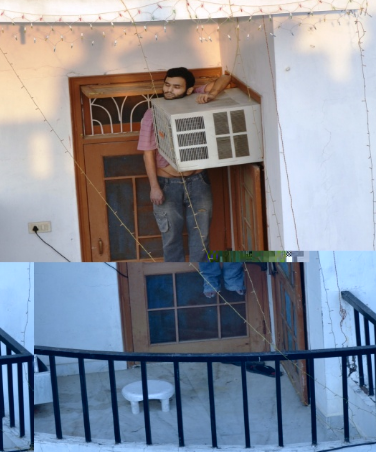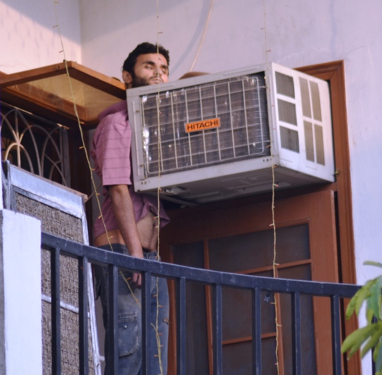- Visibility 71 Views
- Downloads 12 Downloads
- DOI 10.18231/j.ijfmts.2020.034
-
CrossMark
- Citation
Accidental Hanging between ventilation window and air condition unit a very unusual death- A case report
- Author Details:
-
Mohd Kaleem Khan
-
Kashif Ali *
Introduction
Hanging is the most common method adopted for committing suicide in India as per the data published by the National Crime Records Bureau (NCRB) India in 2015 followed by poisoning and other methods.[1] Hanging is a form of ligature strangulation by the application of external pressure on the neck, either by a ligature or by any other material and the constrictions force derived from gravitational pull in the body.[2] Most of the cases reported of hanging are suicidal in nature where as accidental hanging is reported infrequently in children. In adults few cases of accidental hanging are reported linked to alcoholic intoxication, drug abuse and autoerotism. [3]
Hanging is a form of death which is due to either deliberate or incidental self-suspension, while strangulation is regularly homicidal in nature but sometimes accidental.[4] Rare and unusual methods employed in hanging attract the thought of recognized researchers for the academic encounters. Assessment of the mode and manner of death in such instances may be unpredictable. It is a great challenge before the autopsy surgeon to decide the manner of death, whether it is suicidal, homicidal or accidental, especially in those cases where no ligature mark and no external injuries.
Case Report
A boy of about 18 years of age was found hanging by the neck, and the neck being caught in between window pane and an external AC unit. AC (air condition) unit. [[Figure 1]]. At the scene of death the boy was found hanging between window pane and It was a complete hanging with no part touching the ground. A small stool was lying on the floor of the terrace, but not long enough to reach the height to which neck was stuck. It seems that the boy climbed through the door of the terrace and opened the pan of the ventilation window for support and wanted to check the AC unit which was not functioning properly, in the mean time his foot slipped from the door support and he hung accidently in between the window pane and AC unit. Over the time his neck became more and more compressed. The death seems to have occurred on the spot of the accident.
The family was away for a marriage ceremony for a day and the boy was alone at home. When the family returned from marriage ceremony they found the door locked from inside and no one opened the door on repeated knocking. One of the family members went to the back of the house to check on the terrace, and he found out the boy hanging between the window pane and AC unit. External examination of the body showed that the deceased was 164 cm tall and 65 kg in weight. He presented with transverse incomplete compression mark (yellowish-brown), present over the anterior-lateral aspect of the neck just below the angle of the mandible on the left side and posterior an obliquely placed compression mark present at the level of the external occipital protuberance with slightly right inclination. Dark post-mortem hypostasis was noted in hands and legs. [[Figure 2]]
No other cardinal signs of asphyxia like congestion, cyanosis and petechiae were observed over any other part of the body. Autopsy findings of the neck showed tissues underneath the mark were dry, white and glistening and no injury to deeper structures of the neck. Brain showed mild congestion and other organs, including lungs, liver, spleen and kidneys showed congestion. Further toxicological analysis of viscera showed no evidence of poisoning.


Discussion
It seems suicidal hanging is the most common method of suicide in the developing world.[5] Homicidal hanging is rare and ordinarily it happens to the individuals who can’t resist to the external force, especially children, elderly, inebriated or under the influence of drugs.[6]
The accidental hanging can be truly circumstantial and most recurrent cases reported are in relation to professional or leisure activities such as parachuting and mountaineering.[7] The seat belts or an electric powered window of the cars also has been reported to cause accidental hanging.[8] Accidental hanging can be intentional, such as in autoerotic asphyxia, but the victim does not expect the death.[9], [10], [11], [12], [13], [14]
In present case great caution was needed to examine the death scene, to do the post mortem of the body and to evaluate deceased past medical and social history as the circumstances of accidental hanging were extremely rare and unusual. The deceased had no mental illness or past suicide attempts and had no declaration of self-destructive ideation. The homicide could not be suspected as there were no signs of struggle and trauma and the presence of any other person at home at that time.
It was a tough task to assume that what would have happened and what may be the scientifically possible mechanism of injury. The two forces were found acting on the neck, one from the postero-lateral aspect of the back of the neck with the edge of window pane and another from right Antero-lateral aspect of the neck by the edge of AC unit along with body weight.
The neck is quite a vulnerable structure and in its small diameter it contains neurovascular bundle and the airway. The other vital structures are vertebral arteries and vertebral column with spinal cord. Any amount of external force will lead to compression of neck structures starting from the jugular vein to the carotid artery and lastly vertebral artery depending upon the amount of force applied.[15] External force can harm a considerable lot of these important structures. Venous blockage prompts cerebral congestion and petechiae develop on the face, continued blockage of venous blood may lead to rupture of blood vessels and hemorrhagic stroke.[16] Pressure over the carotid artery causes low cerebral blood flow and cerebral hypoxia. Unilateral carotid artery blocked can cause neurological deficits on the opposite side of the body due to cerebral hypoxia. Thrombosis can form in blocked vessels. Thrombus already formed in blood vessels can dislodge and can get lodged in brain causing stroke and leading to ischemia.[17]
Pressure over the carotid sinuses causes over stimulation of the vagus nerve that leads to increased parasympathetic tone which causes cardiac arrest. Pressure on the carotid body is well known to produce bradycardia and cardiac arrest by the incitement of the process called carotid sinus reflex.[18] The role of this reflex in the pathophysiology of strangulation is thought to be infrequent, as a force must be applied to a specific and localized area. To induce bradycardia within the second that’s results in cardiac arrest; the force must be maintained for a minimum of 3-4 minutes.[19]
Conclusion
Hanging is one of the common method techniques of committing suicide. It is considered as suicidal unless proved otherwise. Accidental hanging is rare, though children are vulnerable to it. The study of the accident scene, the forensic autopsy findings, the toxicology analysis and the study of the circumstances of death are essential for drawing opinion.
Suggestion
There is a need for proper authority established by the government to check the proper installation of electrical appliances in the houses.
Housing maps should be passed with proper care for ventilation and place for fitting AC units.
Care should be taken and trained worker should be hired for repair and installation of electrical appliances.
Conflicts of interest
All contributing authors declare no conflicts of interest.
Source of Funding
None.
References
- . Accidental deaths and suicides in India 2015. A 2015 report by NCRB, Ministry of Home Affairs, The Government of India, New Delhi. . [Google Scholar]
- B Knight, P Saukko. Fatal pressure on the neck. In: Knight’s Forensic Pathology. 2004. [Google Scholar]
- KSN Reddy. The essential of forensic medicine and toxicology. 17th Edn. . [Google Scholar]
- K Simpson. Taylor's principal and practice of Medical Jurisprudence. l Z'"edn. . [Google Scholar]
- V Belis. Problemegeneralesi medico-legale ale starilorhipoanoxice. Tratat de medicinalegala 2005. [Google Scholar]
- S Kodikara, R Alagiyawanna. Accidental Hanging by a T-Shirt Collar in a Man with Morphine Intoxication an Unusual Case. Am J Forensic Med Pathol 2011. [Google Scholar] [Crossref]
- P Pelizza. Incomplete hanging: a very interesting case. J. Forensic Med 1995. [Google Scholar]
- RA James, R W Byard. Asphyxiation From Shoulder Seat Belts. Am J Forensic Med Pathol 2001. [Google Scholar] [Crossref]
- W Jansen. Forensic aspects of 40 accidental autoerotic deaths in Northern Germany. Forensic Sci Int 2005. [Google Scholar]
- T Atanasijevic, A Jovanovic, S Nikolic, V Popovic, M Jasˇovic´-Gasˇic´. Accidental death due to complete autoerotic asphyxia associated with transvestic fetishism and anal self-stimulation. Psychiatr Danub 2009. [Google Scholar]
- G Tournel, N Hubert, C Rougé, V Hédouin, D Gosset. Complete Autoerotic Asphyxiation. Am J Forensic Med Pathol 2001. [Google Scholar] [Crossref]
- R. R. Hazelwood, P. E. Dietz, A. W. Burgess. Sexual Fatalities: Behavioral Reconstruction in Equivocal Cases. J Forensic Sci 1982. [Google Scholar] [Crossref]
- LBE Shields, DM Hunsaker, JC Hunsaker. Autoerotic Asphyxia. Am J Forensic Med Pathol 2005. [Google Scholar] [Crossref]
- . Green W: Strangulation. In American College of Emergency Physicians (Eds.), Evaluation and management of sexually assaulted or sexually abused patient,. 2nd Edn. 2013. [Google Scholar]
- V J Di Maio, D Di Maio. Asphyxia. Forensic Pathology. 2nd Edn. 2001. [Google Scholar]
- . Hanged by the neck until dead. The processes and physiology of judicial hanging. 2018. [Google Scholar]
- S H Kiani, D C Simes. Delayed bilateral internal carotid artery thrombosis following accidental strangulation. Br J Anaesth 2000. [Google Scholar] [Crossref]
- DA Hawley, G E McClane, G B Strack. A review of 300 attempted strangulation cases part III: injuries in fatal cases. J Emerg Med 2001. [Google Scholar] [Crossref]
- F. Clarot, E. Vaz, F. Papin, B. Proust. Fatal and non-fatal bilateral delayed carotid artery dissection after manual strangulation. Forensic Sci Int 2005. [Google Scholar] [Crossref]
